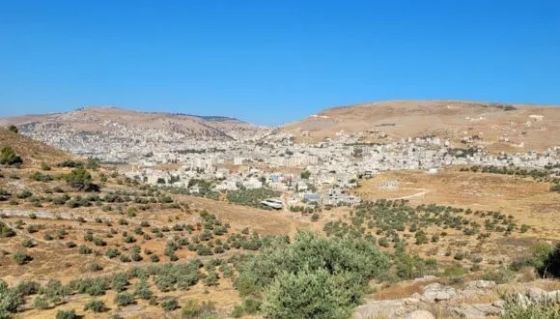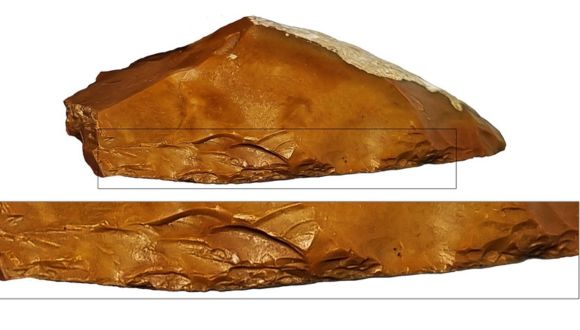
How Did Prehistoric Stone Tools Evolve After Elephants Disappeared?
TAU study identifies tools developed by early humans for butchering fallow deer after elephants disappeared.
A new study from Tel Aviv University identified the earliest appearance worldwide of special stone tools, used 400,000 years ago to process fallow deer. The tools, called Quina scrapers (after the site in France where they were first discovered), were unearthed at the prehistoric sites of Jaljulia and Qesem Cave. They are characterized by a sharp working edge shaped as scales, enabling users to butcher their prey and also process its hides.
The researchers explain that after the elephants disappeared from the region, the ancient hunters were forced to make technological adaptations enabling them to hunt, butcher, and process much smaller and quicker game – fallow deer. The study also found that the unique tools were made of non-local flint procured from the Mountains of Samaria, which probably also served as the fallow deers’ calving area, about 20km east of Jaljulia and Qesem Cave. Consequently, the researchers hypothesize that Mounts Ebal and Gerizim (near Nablus of today) were considered a source of plenty and held sacred by prehistoric hunters as early as the Paleolithic period.
The study was led by Vlad Litov and Prof. Ran Barkai of Tel Aviv University’s Jacob M. Alkow Department of Archaeology and Ancient Near Eastern Cultures. The paper was published in Archaeologies.

Prof. Ran Barkai
The researchers explain that for about a million years, starting 1.5 million years ago, early humans used stone tools called scrapers to process hides and scrape the flesh off the bones of mostly large game. In the Levant, they mainly hunted elephants and other large herbivores that provided most of the calories they needed. The study found, however, that about 400,000 years ago, following the elephants’ disappearance, hunters turned to a different kind of prey, considerably smaller and quicker than elephants – fallow deer.
How Changing Diets Shaped Prehistoric Tools
Litov explains: “In this study, we tried to understand why stone tools changed during prehistoric times, with a focus on a technological change in scrapers in the Lower Paleolithic, about 400,000 years ago. We found a dramatic change in the human diet during this period, probably resulting from a change in the available fauna: the large game, particularly elephants, had disappeared, and humans were forced to hunt smaller animals, especially fallow deer. Clearly, butchering a large elephant is one thing, and processing a much smaller and more delicate fallow deer is quite a different challenge. Systematic processing of numerous fallow deer to compensate for a single elephant was a complex and demanding task that required the development of new implements. Consequently, we see the emergence of the new Quina scrapers, with a better-shaped, sharper, more uniform working edge compared to the simple scrapers used previously”.

A close look at a Quina-like scraper from Jaljulia.
The study relies on findings from an excavation at the Jaljulia prehistoric site next to Highway 6 in central Israel, probably inhabited by humans of the homo erectus species, as well as evidence from the nearby Qesem Cave. At both sites the excavators discovered many scrapers of the new type, made of non-local flint whose nearest sources are the western slopes of Samaria, to the east of the excavated sites, or today’s Ben Shemen Forest to the south.
Prof. Barkai adds: “In this study we identified links between technological developments and changes in the fauna hunted and consumed by early humans. For many years researchers believed that the changes in stone tools resulted from biological and cognitive changes in humans. We demonstrate a double connection, both practical and perceptual. On the one hand, humans started making more sophisticated tools because they had to hunt and butcher smaller, faster, thinner game. On the other, we identify a perceptual connection: Mounts Ebal and Gerizim in Samaria, about 20km east of Jaljulia, were a home range of fallow deer and thus considered a source of plenty. We found a connection between the plentiful source of fallow deer and the source of flint used to butcher them, and we believe that this link held perceptual significance for these prehistoric hunters. They knew where the fallow deer came from and made special efforts to use flint from the same area to make tools for butchering this prey. This behavior is familiar from many other places worldwide and is still widely practiced by native hunter-gatherer communities”.
Samaria’s Sacred Role in Early Tool Evolution
Litov concludes: “We believe that the Mountains of Samaria were sacred to the prehistoric people of Qesem Cave and Jaljulia because that’s where the fallow deer came from. It’s important to note that in Jaljulia we also found numerous other tools made of different kinds of locally-procured stones. When the locals realized that the elephant population was dwindling, they gradually shifted their focus to fallow deer. Identifying the deer’s plentiful source, they began to develop the unique scrapers in the same place. This is the earliest instance of a phenomenon that later spread throughout the world. The new scrapers first appeared at Jaljulia on a small scale, about 500,000 years ago, and a short time later, 400,000 to 200,000 years ago, on a much larger scale at Qesem Cave. The Samarian highlands east of Jaljulia and Qesem Cave were likely the home range of a fallow deer population, as evidenced by bone remains recovered from local archaeological sites throughout the Pleistocene and Holocene. Many fallow deer bones were also found at the altar site on Mount Gerizim, attributed in the Old Testament to Joshua bin Nun, and identified by some traditions as the place of Abraham’s Covenant of the Pieces described in the Book of Genesis. Apparently, the Mountains of Samaria gained a prominent, or even sacred status as early as the Paleolithic period and retained their unique cultural position for hundreds of thousands of years”.
